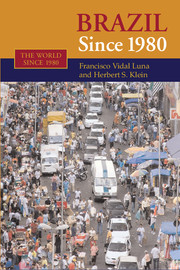Book contents
4 - Agriculture
Published online by Cambridge University Press: 03 June 2010
Summary
Brazilian agriculture represents perhaps the most important example of modernization in the country's economy. In half a century, the country went from an archaic, concentrated, and low-productivity enterprise to a modern and competitive agricultural system, one that has successfully penetrated international markets. Its market participation is continually growing and today it is the world's third largest exporter of agricultural products after the United States and the European Union. It also has become a leading player in international organizations, demanding a greater freedom of commerce to increase its exports, which have been limited by the agricultural protectionism of the developed countries.
Brazil's international levels of competitiveness is evident in products such as soybean, orange juice, meats, sugar, and cellulose, to name just a few of its important crops. In fact, for many of these crops, for example, coffee, sugar, orange juice, and unprocessed soybeans, it is the world's largest exporter. Allied to agriculture, an industrial complex with great importance in the country's industrial system was formed, supplying agriculture consumables and equipment for processing of these primary products. The estimate is that the agribusiness, which includes all the stages from planting to processing, represents more than 30 percent of the Brazilian GDP, accounts for more than a third of the existing jobs and about 40 percent of exports. It is a major component in Brazilian's foreign trade and a major factor in its high commercial export surpluses.
- Type
- Chapter
- Information
- Brazil since 1980 , pp. 101 - 135Publisher: Cambridge University PressPrint publication year: 2006



